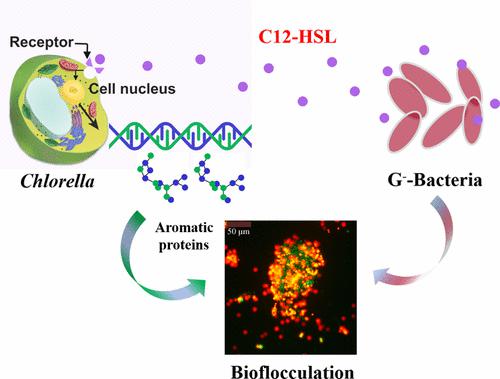当前位置:
X-MOL 学术
›
Environ. Sci. Technol.
›
论文详情
Our official English website, www.x-mol.net, welcomes your
feedback! (Note: you will need to create a separate account there.)
N-Acyl-Homoserine Lactone (AHL)-Mediated Microalgal–Bacterial Communication Driving Chlorella-Activated Sludge Bacterial Biofloc Formation
Environmental Science & Technology ( IF 10.8 ) Pub Date : 2022-07-26 , DOI: 10.1021/acs.est.2c00905
Hong Wang 1, 2, 3 , Peike Wu 1, 2 , Dan Zheng 1, 2 , Liangwei Deng 1, 2 , Wenguo Wang 1, 2
Environmental Science & Technology ( IF 10.8 ) Pub Date : 2022-07-26 , DOI: 10.1021/acs.est.2c00905
Hong Wang 1, 2, 3 , Peike Wu 1, 2 , Dan Zheng 1, 2 , Liangwei Deng 1, 2 , Wenguo Wang 1, 2
Affiliation

|
N-acyl-homoserine lactones (AHLs) as autoinducers of Gram-negative bacteria for quorum sensing regulation have shown positive effects on the production of aromatic proteins in extracellular polymeric substances (EPSs) during bioflocculation. To investigate the role of AHLs in aromatic protein production, a Chlorella–bacteria system with great bioflocculation was established via fed-batch cultivation. Tryptophan and aromatic proteins as the main compounds in the EPS of bioflocs showed an increasing trend during fed-batch cultivation. The Chlorella cells only secreted tryptophan rather than aromatic proteins during axenic cultivation. N-dodecanoyl-l-homoserine lactone (C12-HSL) was correlated with the flocculation activity and extracellular protein content of bioflocs during fed-batch cultivation. The addition of exogenous C12-HSL enhanced the flocculation activity of the Chlorella–bacteria system and aromatic protein production in the EPS. Chlorella cells sensed exogenous C12-HSL and significantly upregulated the aromatic protein synthesis pathway during axenic cultivation. In addition, vanillin as a quorum-sensing inhibitor suppressed the positive effect of C12-HSL on flocculation activity and aromatic protein production and synthesis. This result indicated that vanillin intercepts the response of Chlorella cells to C12-HSL. Overall, C12-HSL is supposed to be an important signal molecule to achieve communication between Chlorella and Gram-negative bacteria and subsequently induce Chlorella cells to produce aromatic proteins for biofloc formation.
中文翻译:

N-酰基高丝氨酸内酯 (AHL) 介导的微藻细菌通讯驱动小球藻活化污泥细菌生物絮团形成
N-酰基高丝氨酸内酯(AHLs)作为革兰氏阴性菌的自诱导剂用于群体感应调节,在生物絮凝过程中对胞外聚合物(EPSs)中芳香蛋白的产生具有积极作用。为了研究 AHL 在芳香蛋白生产中的作用,通过补料分批培养建立了具有良好生物絮凝性的小球藻-细菌系统。色氨酸和芳香蛋白作为生物絮团EPS中的主要成分,在补料分批培养过程中呈上升趋势。小球藻细胞在无菌培养过程中只分泌色氨酸而不是芳香蛋白。N-十二烷酰-l-高丝氨酸内酯(C12-HSL)与补料分批培养过程中生物絮团的絮凝活性和细胞外蛋白含量相关。添加外源 C12-HSL 增强了小球藻-细菌系统的絮凝活性和 EPS 中芳香蛋白的产生。小球藻细胞在无菌培养过程中感知外源 C12-HSL 并显着上调芳香蛋白合成途径。此外,香草醛作为群体感应抑制剂可抑制 C12-HSL 对絮凝活性和芳香蛋白生产和合成的积极影响。该结果表明香兰素拦截了小球藻的反应细胞到 C12-HSL。总体而言,C12-HSL 被认为是实现小球藻与革兰氏阴性菌之间通信并随后诱导小球藻细胞产生用于生物絮凝物形成的芳香蛋白的重要信号分子。
更新日期:2022-07-26
中文翻译:

N-酰基高丝氨酸内酯 (AHL) 介导的微藻细菌通讯驱动小球藻活化污泥细菌生物絮团形成
N-酰基高丝氨酸内酯(AHLs)作为革兰氏阴性菌的自诱导剂用于群体感应调节,在生物絮凝过程中对胞外聚合物(EPSs)中芳香蛋白的产生具有积极作用。为了研究 AHL 在芳香蛋白生产中的作用,通过补料分批培养建立了具有良好生物絮凝性的小球藻-细菌系统。色氨酸和芳香蛋白作为生物絮团EPS中的主要成分,在补料分批培养过程中呈上升趋势。小球藻细胞在无菌培养过程中只分泌色氨酸而不是芳香蛋白。N-十二烷酰-l-高丝氨酸内酯(C12-HSL)与补料分批培养过程中生物絮团的絮凝活性和细胞外蛋白含量相关。添加外源 C12-HSL 增强了小球藻-细菌系统的絮凝活性和 EPS 中芳香蛋白的产生。小球藻细胞在无菌培养过程中感知外源 C12-HSL 并显着上调芳香蛋白合成途径。此外,香草醛作为群体感应抑制剂可抑制 C12-HSL 对絮凝活性和芳香蛋白生产和合成的积极影响。该结果表明香兰素拦截了小球藻的反应细胞到 C12-HSL。总体而言,C12-HSL 被认为是实现小球藻与革兰氏阴性菌之间通信并随后诱导小球藻细胞产生用于生物絮凝物形成的芳香蛋白的重要信号分子。

































 京公网安备 11010802027423号
京公网安备 11010802027423号